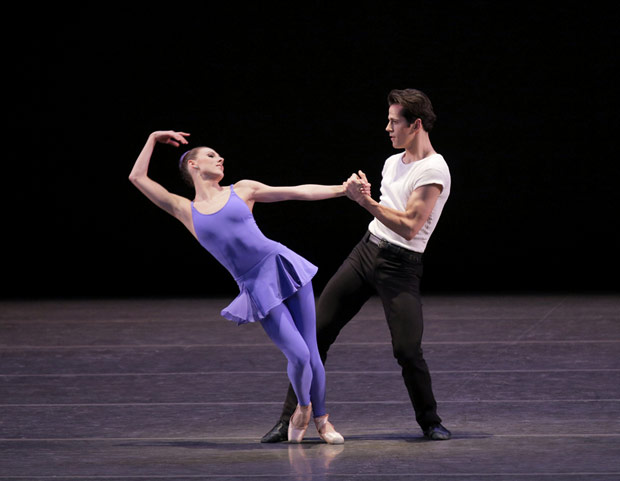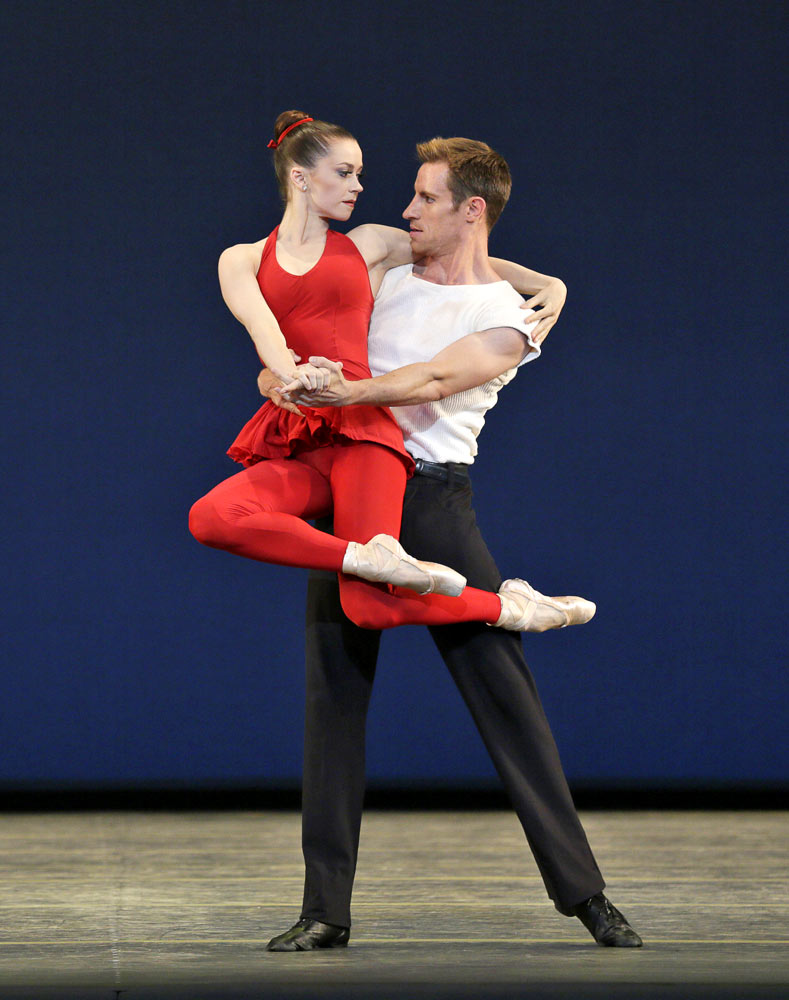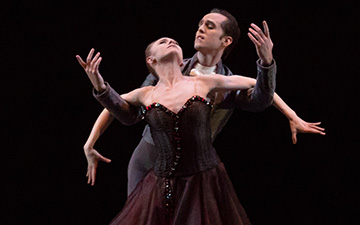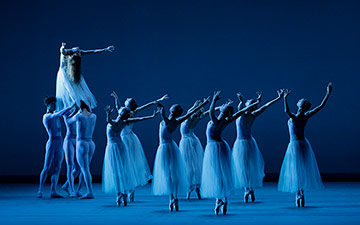
© Paul Kolnik. (Click image for larger version)
Carbon Dating a Dance: Opus Jazz and The Waltz Project
New York City Ballet
The Waltz Project, N.Y. Export: Opus Jazz, and Piano Concerto No. 2
New York, David H. Koch Theater
5 February 2013
www.nycballet.com
The season plugs along and the next thing you know, you’re halfway through it. In just a matter of days (on Feb. 12) New York City Ballet will plunge into full fairytale mode with two weeks of the company’s streamlined, elegant, and really quite pleasing Sleeping Beauty (staged by Peter Martins). The novelties this week are the revival of Martins’ The Waltz Project (which has not been performed here for over a decade) and the return of the more familiar N.Y. Export: Opus Jazz, by Jerome Robbins. The evening’s closing number was the grand, imperial Tchaikovsky Piano Concerto No. 2, which I reviewed earlier in the season.
I’ll start with Opus Jazz. It’s quite stirring to see how the company has embraced this ballet since first performing it in 2005. Originally made (in 1958) for Robbins’ own touring company, it still has the feel of a declaration: “Here we are, America’s youth.” It’s a period piece, performed in sneakers, an echo of the Beats and bebop, the mambo craze and West Side Story, Robbins’ huge hit of 1957. Pre rock-and-roll, pre sexual revolution. The dancers are kids, but not the innocent, cutesy kids from Interplay (1945). (Nor are they the knowing, frankly sexual adults of Balanchine ballets like Stravinsky Violin Concerto.) They have an edge; a modern-day psychologizer might categorize them as being “at risk.” They spend too much time on their own, fooling around and trying to put a lid on their pent-up energy and sexual urges. In the dance at the gym section (Improvisations), their jazzy, playful one-upmanship keeps devolving into pelvic bumps, to the mock consternation of the others. They cry out, “hey!” a tad unconvincingly. If only they’d seen krumping, or William Forsythe for that matter.
Passage for Two section from the film version of NY Export: Opus Jazz and reviewed by Eric Taub for Balletco in May 2010.
Nevertheless, I’m always surprised at how sexual Opus Jazz really is – remember, it was made in the fifties – especially the two middle sections, Statics and Passage for Two. In Statics, three guys hang out on a rooftop – denoted by a few chimneys outlined against a dark sky, by Ben Shahn – lunging and sliding, kicking and making fists. They’re gaming for a fight. The accompaniment is all percussion (by Robert Prince), drums and cowbells, thumping syncopations. Into this hotbed of male adolescent aimlessness saunters Georgina Pazcoguin, super-sexualized and over-confident, taunting them with her curves. (Pazcoguin is absolutely sensational here, as she is in most Robbins or anytime she gets to play a character.) She courts danger with a kind of thoughtless defiance. “Bring it on!” she seems to say, holding her arms out as she shakes her bum at the circle of boys. Then she picks one – with her eyes closed – for a kind of aggressive foreplay. More men arrive, more clenched fists. She’s tough, but she’s completely outnumbered. As in Fancy Free, Robbins shows an amazing ability to capitalize on simple math; three sailors and two girls equals a stick situation. One girl and a pack of teen-aged boys equals danger. Just as you’re beginning to really worry, they throw her offstage, with a violent toss. The audience always gasps.

© Paul Kolnik. (Click image for larger version)
On Feb. 5 Chase Finlay had his début in the role of the boy in Passage for Two, the rather equivocal duet that comes just before the more formal, fugue-like finale. It’s a heartbreaking little dance, full of sexual longing and unresolved adolescent feelings. As a bluesy trumpet sings out a melancholy tune, two figures approach each other from opposite corners with a certain diffidence, eyes averted. It’s clear things won’t end well, and equally clear that these two will end up in each other’s arms, no matter what. The attraction is just too strong. Ashley Laracey approaches this private dance with her usual aura of poetry and vulnerability. Finlay, impossibly handsome in a blonde and broad-shouldered kind of way, could not be more perfectly suited to the role of the iconic all-American boy. Like Warren Beatty in Splendor in the Grass, he’s irresistible but full of rough edges you can’t see. The seriousness Finlay exhibits onstage – as if thinking very hard about the steps – serves the scene’s atmosphere beautifully. He puts one hand on Laracey’s hip, and you can feel her melt. The two embrace, close to the floor, wrapping around each other, but his body remains clenched, his hands in fists. It’s a very sexy pas de deux, especially when danced with this kind of raw simplicity. But the encounter brings no sense of bliss – despite the sudden appearance of one of Robbins’ astonishing lifts, out of nowhere – and the two walk off in opposite directions, more alone than when they arrived.

The ensemble cast of dancers of the New York City Ballet, Andrew Veyette and Ashley Laracey in the foreground, in the “Improvisations” section, filmed in a school gymnasium in Carroll Gardens, Brooklyn.
© Kate Reeder. (Click image for larger version)
N.Y. Export: Opus Jazz is certainly not Robbins’ finest or most original work but perhaps because of its relative straightforwardness, it reveals much about what is so remarkable about this choreographer. First of all, how attuned he was to the particular psychology of youth, especially of midcentury America. How well he used popular dances like the mambo, as well as the attitudes he observed in everyday life and the movies. On a more formal level, one is struck by how clever and natural his group dances are – the way a line advances, for example, and sweeps up the other dancers on the stage. Or how four boys poke fun at Balanchine’s endless daisy-chains in the Improvisations section. Or how an indistinct clump of bodies begins to dissolve, like sand in an hourglass, a line of bodies dribbling out and spreading across the stage. And finally there is Robbins’ unmatched ability to create a private world onstage. This may be the key to understanding why dancers still respond so vividly to his dances, despite their occasional artifice. Opus Jazz may be a period piece, but it doesn’t feel dated. (With the exception of the costumes: bulky, ill-fitting sweatshirts over shiny tights.)

© Paul Kolnik. (Click image for larger version)
Strangely enough despite its abstract, rigorously formal structure Peter Martins’ Waltz Project (1988) seems more dated. Watching it, I felt as if I were seeing a work made to highlight the specific qualities of particular dancers, not the ones I had before me. Unlike Opus Jazz, which varies slightly in tone with every cast, Martins’ ballet, without its original interpreters, feels like an empty exercise, no matter how ingenious the steps or prodigious their execution. The concept is intriguing: an exploration of the waltz (more as a musical form than as a dance) for four couples. Originally made for the company’s American Music Festival, it is set to nine piano pieces by twentieth-century American composers, from Robert Moran to Philip Glass. (As always, the pianist Cameron Grant played with clean, understated stylishness.) This is a musical territory to which Martins is often drawn. For the most part, the music is not easy for the ear to decipher – this is not Johan Strauss we’re talking about – and the dancing has a similar complexity, like an extended experiment in the complexities of partnering. The women are folded, bent, lowered, lifted, flipped, and spun in countless ways. Each duet has a theme. Megan Fairchild and Andrew Veyette dance a kind of tango, full of striking, dramatic poses. Veyette holds Fairchild horizontally above his head and then folds her in half, like a pocket knife, as he slowly lowers her to the ground. (What is strange here is that Fairchild is not at all an angular, chic kind of dancer, which makes her look simply constrained in this duet, as if forced to rein in her sunny disposition.) Tiler Peck flirts mercilessly with her partner, Robert Fairchild, in Ivan Tcherepnin’s Valse Perpetuelle and even more in Tom Constanten’s Dejavalse, where she swivels her hips, hops around, and strikes playful come-hither poses like a naughty cheerleader. Robert Fairchild gamely plays along. (The two have a natural rapport and are the most at home in the style assigned to them.) Savannah Lowery’s duets with Adrian Danchig-Waring are more tumultuous; for the most part her focus seems to be on getting away, but inevitably he drags her back, only to pick her up in big, upside-down or otherwise off-kilter positions. Teresa Reichlen, dressed in orange – each couple has a color – is pale and serene, spinning and gliding across the stage in a blissed-out bubble. Her first duet with Ramasar is set to Philip Glass’s Modern Love Waltz, a folksy tune that is the ballet’s most superficially appealing musical selection. Martins’ choreography for the couple has a nice lilt to it, full of swings, spins and slow walks side by side. That is until the end, when Ramasar pulls and pushes his partner in a sequence of gymnastic multi-part moves – down to the floor, up to the shoulder and back down between his legs. The two walk off looking like they swallowed a canary. Waltz Project is a strange piece, never less than interesting to watch, surely challenging to dance, but lacking in tone, as if the dancer never quite connected with the dance.

















[…] Here’s my review of Tuesday’s program at New York City Ballet, which featured the return of Jerome Robbins’ N.Y. Export: Opus Jazz and Peter Martins’ rarely performed Waltz Project. […]
What a great last line: “but lacking in tone, as if the dancer never quite connected with the dance.” Makes me rethink the commonplace:
And what amazing commentary on this Robbins–and Robbins as a whole. Brava!